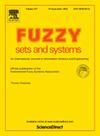一种评价最近邻分类的统一加权框架
IF 2.7
1区 数学
Q2 COMPUTER SCIENCE, THEORY & METHODS
引用次数: 0
摘要
本文首次对经典(NN)、模糊(FNN)和模糊粗糙(FRNN)的最近邻分类进行了全面、大规模的评价。我们用核函数对现有的最近邻加权建议进行标准化,应用于测试实例的最近邻的距离值和/或秩。特别地,我们证明了理论上最优的Samworth权收敛于一个核。核函数与模糊负算子密切相关,本文提出了一种基于Yager负的核函数。我们还考虑了各种距离和尺度度量,我们表明它们可以相互关联。通过对85个真实分类数据集进行系统的一系列实验,我们发现,NN、FNN和FRNN在使用Boscovich距离时都表现最好,并且NN和FRNN在使用Samworth秩权和距离权并通过中位数(r1)、标准差(r2)或半四分位数范围(r∞)的平均绝对偏差进行缩放时表现最好,而FNN仅使用Samworth距离权和r1或r2进行缩放时表现最好。然而,神经网络与Yager-12距离权值的性能相当,它比Samworth距离权值和排名权值的组合更容易实现。最后,FRNN总体上优于NN,而NN的系统性能又优于FNN。本文章由计算机程序翻译,如有差异,请以英文原文为准。
A unified weighting framework for evaluating nearest neighbour classification
We present the first comprehensive and large-scale evaluation of classical (NN), fuzzy (FNN) and fuzzy rough (FRNN) nearest neighbour classification. We standardise existing proposals for nearest neighbour weighting with kernel functions, applied to the distance values and/or ranks of the nearest neighbours of a test instance. In particular, we show that the theoretically optimal Samworth weights converge to a kernel. Kernel functions are closely related to fuzzy negation operators, and we propose a new kernel based on Yager negation. We also consider various distance and scaling measures, which we show can be related to each other. Through a systematic series of experiments on 85 real-life classification datasets, we find that NN, FNN and FRNN all perform best with Boscovich distance, and that NN and FRNN perform best with a combination of Samworth rank- and distance-weights and scaling by the mean absolute deviation around the median (), the standard deviation () or the semi-interquartile range (), while FNN performs best with only Samworth distance-weights and - or -scaling. However, NN achieves comparable performance with Yager- distance-weights, which are simpler to implement than a combination of Samworth distance- and rank-weights. Finally, FRNN generally outperforms NN, which in turn performs systematically better than FNN.
求助全文
通过发布文献求助,成功后即可免费获取论文全文。
去求助
来源期刊

Fuzzy Sets and Systems
数学-计算机:理论方法
CiteScore
6.50
自引率
17.90%
发文量
321
审稿时长
6.1 months
期刊介绍:
Since its launching in 1978, the journal Fuzzy Sets and Systems has been devoted to the international advancement of the theory and application of fuzzy sets and systems. The theory of fuzzy sets now encompasses a well organized corpus of basic notions including (and not restricted to) aggregation operations, a generalized theory of relations, specific measures of information content, a calculus of fuzzy numbers. Fuzzy sets are also the cornerstone of a non-additive uncertainty theory, namely possibility theory, and of a versatile tool for both linguistic and numerical modeling: fuzzy rule-based systems. Numerous works now combine fuzzy concepts with other scientific disciplines as well as modern technologies.
In mathematics fuzzy sets have triggered new research topics in connection with category theory, topology, algebra, analysis. Fuzzy sets are also part of a recent trend in the study of generalized measures and integrals, and are combined with statistical methods. Furthermore, fuzzy sets have strong logical underpinnings in the tradition of many-valued logics.
 求助内容:
求助内容: 应助结果提醒方式:
应助结果提醒方式:


